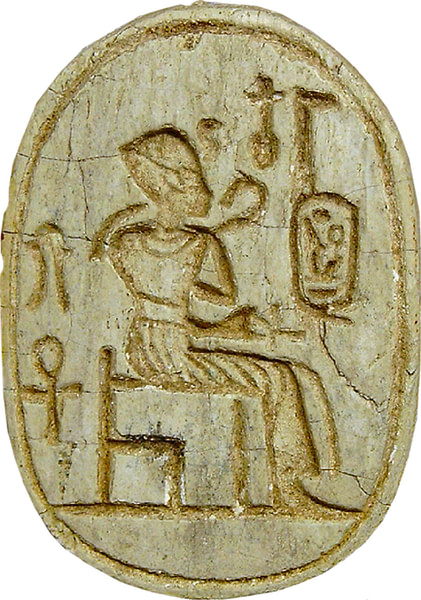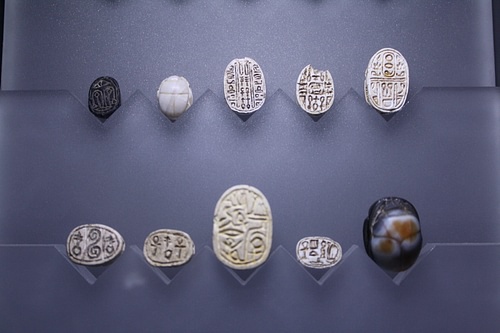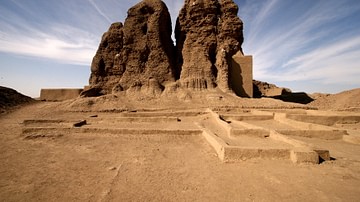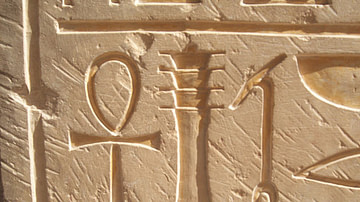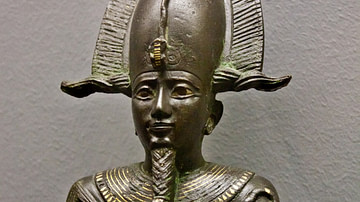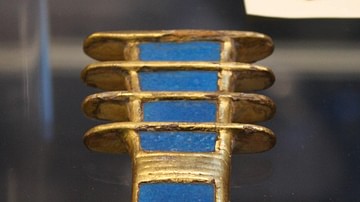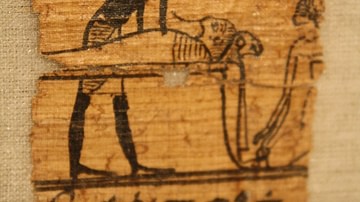Material Objects & Cultures
Material objects convey volumes about the people who possessed them. Cultures and societies in every generation are in part classified - either correctly or incorrectly - by the objects or symbols they select and how they are displayed. Typically, the formal study of society is the purview of anthropologists and social scientists who categorize 'people' into cultural assemblages which are extrapolated from commonly held 'features' (e.g. clothing, jewellery, and music) and their interpersonal behaviour (e.g. occupation, political activities, rand eligious practices) which socially defines them. Hence, any answer to the 'meaning of things' in society, generally speaking, is a structured hypothesis.
Amulets are an example of such culturally defining objects, and they satisfied a variety of roles in the society of Ancient Egypt. Specifically, they possessed complex socio-religious meanings which are reflected in their diverse designs and, therefore, may be analyzed within ontological/phenomenological and/or structural/poststructural dichotomies. In this article, I shall discuss Egyptian amulets as objects of human expression; exploring their symbolism and utilization in socio-cultural functions.
Life Before Death
Culturally, amulets were intimately associated with the greater Egyptian religious system, which was a state system whose earliest cosmological views of nature contained a cyclical perception of life, death, and rebirth. Typically, amulets were worn as jewellery by both men and women in social settings. However, they were not worn as a mere ornamental feature or simply as a sign of religious devotion. Rather, the amulet was regarded as a talisman. That is to say - metaphysically speaking - each amulet was understood to possess a precise supernatural attribute which could be imparted to those who wore them. The spiritual value of the amulet depended entirely on what specific enchantment was assigned to it and how it was employed. For example, to increase an amulet's potency, a sacrosanct 'inscription' may have been added to ascribe a certain spell. Unprovenanced specimens reveal wishes for a 'happy new year' or 'health and prosperity' and from this feature, we may deduce its owner's socio-economic needs or personal desire.
Ankh - Symbol of Life
Inversely, while the selection of a particular amulet may indeed signify an aspect of an individual's identity, the amulet itself - symbolizing a commonly held concept - also denoted a larger social system of beliefs that were intra-culturally understood. Thus, one of the ways of establishing their meaning is through the 'reading' of amulets within their cultural setting. For example, amulets that were carved in the form of the ☥, or ankh, were understood to impart the mystical properties of 'everlasting life'. In an abstract sense, this may be construed from the hieroglyph ☥ which is simply translated as 'life'.
While standalone amuletic ankhs are extremely rare, examples of the design can commonly be seen engraved on other amulets, such as the bull-bat cult specimen from Naga ed-Deir. Additionally, an ankh pendant has been found at el-Amarna, the capital of Akhenaten. Its discovery at Akhetaten - a city dedicated to the dissemination of monotheism - is a small yet intriguing example of the durability of Old to New Kingdom iconography during the turbulent Amarna Period.
The story behind this particular design is unsettled amongst scholars. For example, it is known from First Intermediate Period (2160-2055 BCE) inhumations that some amulets had anatomical associations with the human body. Hypothetically, considering the ankh's known hieroglyphic meaning of 'life', one may infer a possible phallic origin for its lower cross-stem extension. In addition, the shape of the loop-handle has led some to propose a yonic interpretation. If this is true, a parallel with ancient Egyptian binary concepts regarding existence such as order/chaos, creation/destruction, and birth/death may be inferred. Furthermore, when considering the fact that the earliest ankhs have been contextually dated to the First Dynasty (3000-2890 BCE) - a time when according to Egyptian cosmology chaos and ruins were replaced by order and creation - an archaeological context that coincides with the historical 'birth' of ancient Egypt may be established.
Consequently, what we may be observing is a cognitive association between the Egyptian understanding of eternal life, their contemplations about creation, and their cosmological views regarding connubial relations. By extension, to the ancient Egyptians, the ankh may have been a microcosm of Egyptian history, beliefs, and interpersonal relations. Thus, a symbolic meaning - when found within an Egyptian household - could conceivably be interpreted as a desire for the magical impartation of a sound and happy marriage, prodigious fecundity, and/or a healthy and strong family. In each example, some aspect of biological or societal 'conception' is present (e.g. marriage, procreation). In any case, the ankh, being a unified or intersexual symbol, functions as a cultural sign for the reproductive or cyclical order of nature.
Contextually however, any definitive social interpretation would depend solely on the perception (or subjective experience) of the individual Egyptian living at the time. Thus, while we may seek to establish understandings vis-à-vis social conventions, we cannot conclusively interpret individual intention from the amulet alone, which should remind us of the importance of archaeological context. But even within context, meanings are occasionally murky. For example, it has been noted that the ankh is seldom found in non-royal burials. Deductively, one may infer a quality of 'restriction' or 'aristocratic exclusivity' regarding its use within Egyptian society. Conversely, perhaps natural or human made devastation to 'commoner' burials - in the form of erosion or looting - is the reason for their absence, presenting us with a much distorted picture. Nonetheless, this is only supposition and again shows us the great difficulty in establishing a precise 'meaning' which is here reflected in the incomplete, and ever evolving, archaeological record.
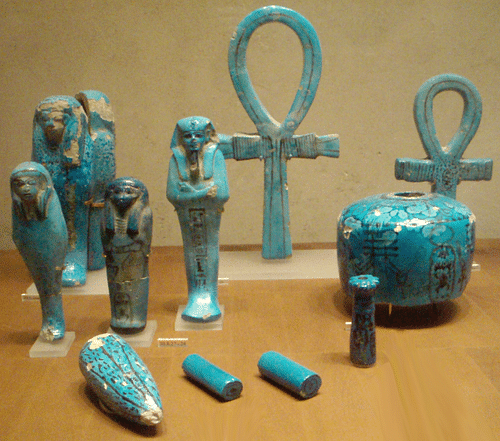
Afterlife: The Ankh Revisited
The ritualistic burials of the ancient Egyptians represent some of the most researched areas of both archaeology and the related field of Egyptology. Fascinatingly, the Egyptian burial was associated with another interpretation of life. One that was linear yet just as associated with immortality: the afterlife. From an Egyptologist's point of view, the Egyptian social view of death would reflect their teleological perception of existence. However, during the Middle Kingdom to Second Intermediate Periods (2055-1550 BCE) amulets are most frequently found in burials ranging from Kerma and Aniba in Lower Nubia, to Tell el-Dab'a in Lower Egypt.
Additionally, some of the most prolific burial specimens are those modeled on the Scarabaeus sacer, or scarab, such as those found at el-Lisht and Tell el-Dab'a (Budge 1989: 231-34; Ben-Tor 2000: 48). While the scarab symbolizes life, its emphasis is more specifically the 'cyclicality of life' associated with the god Kheper. Why introduce a symbol of rebirth after death? Surely this is paradoxical to the linearity of birth-life-death reflected in the burial itself? Budge suggested that this simply reflects the Egyptian belief in the daily 'revivification of the body'. However, I posit that there was a hidden meaning symbolized in the selection of these burial goods; moreover, that there was an understanding vis-à-vis life as experienced by the ancient Egyptians for which we are unable to offer a contemporary analogy.
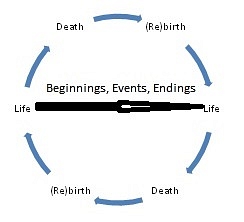
For example, in burial contexts, amulets are typically interpreted as a magical means of protection for the deceased's body in the afterlife. However, this implies that the laws governing the afterlife paralleled the laws of the physical or natural world. What can be said then? If considering the frequent use of the scarab in entombments, we may deduce that the spiritual afterlife may have been so closely related to natural (or physical) 'regeneration' that they were indistinguishable to the ancient Egyptian experience. Thus, it could be hypothesized that the cyclical concept of 'regeneration' - as was observed in days, seasons, festivals, rebirth, etc. - is inextricable from the linear narrative of birth, life, death and afterlife.
Accordingly, it may be argued that the ancient Egyptians possessed a unique metaphysical view of existence, one which amounted to a 'continuity of life' regarding reality itself. Cosmologically, death may have been viewed as a simple mechanism which allowed an individual to move to another 'place' in 'time or space', where 'life continued' unaltered and the 'nature of things' essentially remained unchanged, not unlike moving from one city to another. If this is true, then any analysis of artifacts deposited with the dead should be interpreted within the larger material culture. For example, the necklace of Princess Kh-nu-met from the Lower Egyptian necropolis of Dahshur, may be a symbol of not just political authority in this life, but indicative of the hierarchal continuity regarding her 'place' in the next.
Additionally, the cultural democratization that was occurring by the Middle Kingdom suggests that these beliefs may have transcended various social strata. However, the scant burial evidence of ankhs makes thorough analysis rather difficult. Nevertheless, synthesizing the scarab's meaning as a sign of regenerating life with the somewhat inverted definition of eternal life for the ankh, a simultaneous linear/cyclical dichotomy for both signs is plainly visible. Moreover, when considered within a burial context, a dualistic contextualization of life that begins at physical birth and continues after the death of the body is evident in Egyptian society. Consequently, it may be argued that the ancient Egyptians viewed the physical death as the telos, or very purpose of existence, with the ☥ representing the promise of spiritual rebirth and of the life to come.
Finale of Understandings
There is no real way to 'make an end' to understanding material things. Objects, just as the people who created them, possess a reservoir of social, political, and economic depth to which the human mind cannot at any one time entirely comprehend. Nihilistic interpretations of society, such as Derrida's view that 'there is nothing outside the text', invites contradiction from ontological, epistemological, phenomenological, even theological scholars in an attempt to 'reconstruct the text', figuratively speaking. The impact such academic debate has on the meaning of material culture is difficult to measure, but for archaeologists who study ancient societies, it is even more pertinent to be as objective as possible when reconstructing culture from artifacts. For example, on the one hand, material culture contains a literal (or simple) meaning that is typified by its function within a society. On the other hand, the ideological and metaphysical reality of an object as it was 'known' or experienced by an individual within a culture needs to be explored.
In this essay, I have endeavoured to highlight these very points by synthesizing a wide battery of theoretical approaches to interpret material objects. To accomplish this, I have used an interdisciplinary framework focused on ancient Egyptian amulets to emphasize an archaeological approach to the understandings of objects. My goal was to show how no one interpretation is irrefutable, while no single interpretation is necessarily inaccurate. In conclusion, for archaeologists, the meanings of things are essential to our appreciation of past cultures. Wherefore, let us be flexible as we engage in the critical analysis of material remains.
